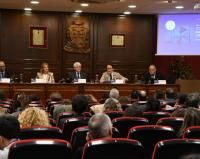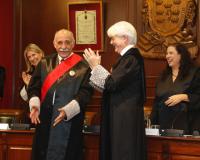
1. Hechos.
La Sra. Hejduk, fotógrafa profesional de arquitectura, realizó diversas obras fotográficas a partir de los trabajos arquitectónicos del austriaco Georg W. Reinberg. Este, con el consentimiento de la primera, utilizó sus fotografías en el marco de una ponencia organizada por la empresa alemana EnergieAgentur en el año 2004. Posteriormente, la compañía alemana, sin recabar autorización alguna, tomó las fotografías y las puso a disposición del público en su sitio de internet. La Sra. Hejduk, al tener conocimiento de ello, interpuso una acción por vulneración de sus derechos de propiedad intelectual ante los tribunales austriacos. EnergieAgentur presentó una excepción de incompetencia internacional sobre la base de que el sitio de internet en el que se encontraban accesibles las obras no estaba destinado a un público austriaco, sino alemán, como se ponía de relieve en el hecho de que el dominio del sitio fuera “.de”. Por su parte, la actora en el litigio principal consideraba que el hecho de que las fotografías pudieran ser consultadas desde Austria bastaba para atribuir competencia a los tribunales austriacos en virtud de lo dispuesto en el artículo 5.3 del Reglamento 44/2001. En tal tesitura, el Handelsgericht Wien decide plantear cuestión prejudicial ante el TJ.
2. Pronunciamientos.
El apartado 3 del artículo 5 del Reglamento 44/2001 permite que, en materia delictual o cuasidelictual, una persona domiciliada en un Estado miembro sea demandada en otro Estado miembro en el que se haya producido o pudiere producirse el hecho dañoso. Tal y como ha señalado en TJ con anterioridad, la previsión del artículo 5.3, como excepción a la norma general, ha de interpretarse de forma restrictiva. Es por ello que, para que esta norma pueda operar, ha de existir un vínculo de conexión particularmente estrecho entre la controversia y el órgano jurisdiccional del lugar en el que se ha producido o puede producirse el hecho dañoso que justifique la atribución a este último de la competencia para conocer del asunto. Este vínculo de conexión puede darse, bien con el hecho causal u originador del daño, bien con la materialización o el riesgo de materialización de ese daño.
En este caso, el hecho causal es el proceso técnico consistente en poner a disposición del público en internet las fotografías, lo cual tiene lugar en Alemania. Sin embargo, la materialización del daño se produce tanto en Alemania como en Austria, desde donde también es posible acceder a las obras. A estos efectos, el Tribunal señala que no es preciso que el sitio de internet controvertido “se dirija al” o “esté destinado al” Estado miembro del órgano jurisdiccional ante el que se ha ejercitado la acción. Por ello, y como quiera que los derechos de autor de la Sra. Hejduk sobre sus fotografías se encuentran igualmente reconocidos en Austria, el Tribunal estima que son competentes los tribunales austriacos para conocer de una infracción de derechos de propiedad intelectual originada en Alemania pero que despliega sus efectos en Austria al ser accesibles las obras en este Estado a través de internet.
3. Comentario.
La cuestión prejudicial que resuelve el TJ ya había sido planteada en términos prácticamente idénticos en el asunto Pinckney (C-170/12). En la sentencia de 3 de octubre de 2013, el Tribunal de Justicia afirmó que el riesgo de materialización en un concreto Estado miembro de un daño derivado de la infracción de derechos de autor depende exclusivamente de que los derechos cuya infracción invoca el demandante estén protegidos en el territorio de ese Estado miembro y de que sea posible acceder desde ese Estado miembro, a través de internet, a la obra en cuestión.
(Fuente de la información: ANUARIO ELZABURU 2015, recopilatorio de comentarios de jurisprudencia europea en materia de Derecho de Propiedad Industrial e Intelectual que realiza Elzaburu).
Documento citado:
- REGLAMENTO (CE) No 44/2001 DEL CONSEJO de 22 de diciembre de 2000 relativo a la competencia judicial, el reconocimiento y la ejecución de resoluciones judiciales en materia civil y mercantil.
<style="text-align: justify;"="">ENGLISH VERSION </style="text-align:>
<style="text-align: justify;"=""><style="text-align: justify;"="">International jurisdiction in matters concerning online copyright infringement. Judgment of the Court of Justice of 22 January 2015, Art & Allposters (C-441/13).</style="text-align:></style="text-align:>
1. Background.
Ms. Hejduk, a professional photographer of architecture, created a number of photographic works depicting the buildings of the Austrian architect Georg W. Reinberg. He, with Ms. Hejduk’s consent, used her photographs in a conference organised by the Germany company EnergieAgentur in 2004. Subsequently, the German company made the photographs available to the public on its website without consent. When Ms. Hejduk learned that this had happened, she brought an action for copyright infringement before the Austrian courts. EnergieAgentur raised an objection that those courts did not hold international jurisdiction, since the website on which the works were made available to the public was directed at Germany, not Austria, as demonstrated by the fact that the domain name of the website was a “.de” domain. The plaintiff in the main proceedings considered that the fact that the photographs could be accessed from Austria was sufficient to confer jurisdiction on the Austrian courts under Art. 5.3 of Regulation 44/2001. In those circumstances, the Handelsgericht Wien decided to refer a question to the CJ for a preliminary ruling.
2. Findings.
Article 5.3 of Regulation 44/2001 provides that in matters relating to tort, delict or quasi-delict, a person domiciled in a Member State may be sued in another Member State where the harmful event occurred or may occur. As the CJ has pointed out in previous rulings, the provisions of Art. 5.3, as an exception to the general rule, must be interpreted strictly. Consequently, in order for that rule to come into play there must be a particularly close linking factor between the dispute and the courts of the place where the harmful event occurred or may occur, which justifies the attribution of jurisdiction to those courts. That linking factor could lie in either the causal event, or the event giving rise to the damage, or in the occurrence of that damage or likelihood that it will occur. In this case, the causal event is the technical process consisting of making the photographs available to the public on the Internet, which took place in Germany. Nevertheless, the damage occurred in both Germany and Austria, from where the works can also be accessed. In that regard, the Court indicated that it was not necessary for the website in question “to be directed at” or “intended for” the Member State in which the court seised was situated. Consequently, and since Ms. Hejduk’s copyright in her photographs is equally recognised in Austria, the Court considered that the Austrian courts had jurisdiction over an action for copyright infringement originating in Germany but whose damaging effects were felt in Austria, since the works could be accessed online from that Member State.
3. Remarks.
The question referred for a preliminary ruling in this case had already been raised, in virtually identical terms, in Pinckney (C-170/12). In its judgment of 3 October 2013, the CJ confirmed that the likelihood of the occurrence, in a specific Member State, of damage deriving from copyright infringement depends exclusively on whether the rights deemed by the plaintiff to have been infringed are protected in the territory of that Member State and whether it is possible to access the work in question on the Internet from that Member State.
ElDerecho.com no comparte necesariamente ni se responsabiliza de las opiniones expresadas por los autores o colaboradores de esta publicación








